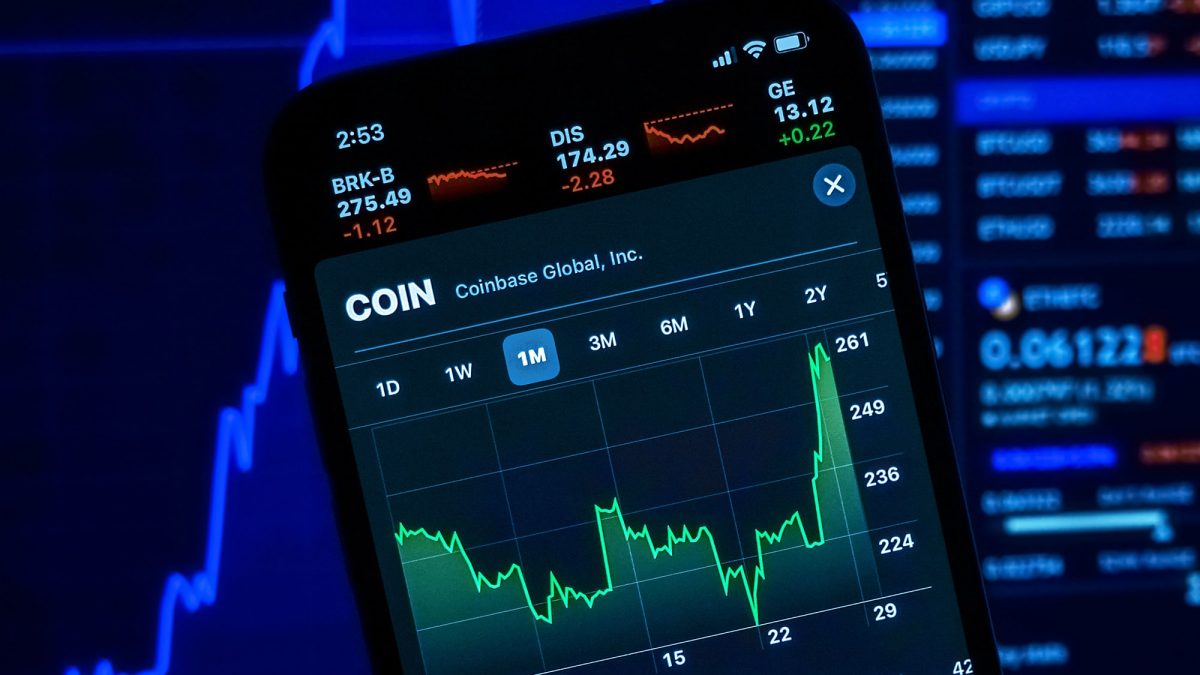

Finance
How To Buy Cryptocurrency Under 18
Published: October 5, 2023
Learn how to buy cryptocurrency under 18 and manage your finances with ease.
(Many of the links in this article redirect to a specific reviewed product. Your purchase of these products through affiliate links helps to generate commission for LiveWell, at no extra cost. Learn more)
Table of Contents
Introduction
Welcome to the world of cryptocurrencies! Cryptocurrency is a digital or virtual form of currency that utilizes cryptography for secure transactions and control the creation of new units. With the rise in popularity and mainstream acceptance of cryptocurrencies like Bitcoin and Ethereum, more and more people are interested in buying and investing in these digital assets.
However, when it comes to cryptocurrency purchases, there are certain legal considerations that need to be taken into account. Additionally, for individuals under the age of 18, there may be additional restrictions and challenges in getting started.
This article will guide you through the process of buying cryptocurrency under the age of 18, outlining the legal considerations, researching the right cryptocurrencies, finding exchanges, setting up and verifying an account, choosing the appropriate cryptocurrency, making a purchase, storing and securing your assets, and monitoring the market.
It’s important to remember that while the following information is provided as a guide, specific regulations and restrictions may vary depending on your country of residence. Always consult with legal and financial professionals to ensure compliance with local laws.
Now, let’s dive into the world of cryptocurrency and explore the steps to buying digital assets under the age of 18.
Legal Considerations
Before venturing into the world of cryptocurrency, it’s important to understand the legal considerations surrounding these digital assets, especially if you are under the age of 18.
First and foremost, you should be aware that the legal age to enter into financial contracts varies from country to country. In some jurisdictions, individuals under the age of 18 may be considered minors and may have limited legal capacity to engage in financial transactions. This means that you may require permission or assistance from a legal guardian or parent to buy and invest in cryptocurrency.
Furthermore, certain countries have specific regulations regarding the buying and selling of cryptocurrencies, with some even imposing age restrictions. It is crucial to familiarize yourself with the laws and regulations of your country to determine the extent to which you can participate in cryptocurrency activities.
Another important aspect to consider is the Know Your Customer (KYC) process. This is a standard procedure implemented by most cryptocurrency exchanges to verify the identity of their users and prevent fraudulent activities such as money laundering. KYC processes often require users to provide personal information, such as a government-issued identification document, proof of address, and in some cases, proof of income.
If you are under 18, you may face challenges completing the KYC process since some exchanges require users to be of legal age to open an account. However, there are exchanges that allow minors to create accounts with proper consent and documentation from a legal guardian or parent. Research and choose an exchange that accommodates the requirements of underage users.
Lastly, keep in mind that the taxation of cryptocurrencies also varies depending on your jurisdiction. Make sure to understand the tax regulations surrounding cryptocurrency investments to ensure compliance with local laws.
Overall, it is crucial to thoroughly research and understand the legal considerations and regulations related to cryptocurrencies in your country before proceeding with any transactions. Seeking guidance from legal professionals can help ensure that you navigate the cryptocurrency space within the bounds of the law.
Researching Cryptocurrencies
Before making any investment decisions, it is important to conduct thorough research on the various cryptocurrencies available in the market. Here are some key factors to consider:
1. Market Cap: The market capitalization of a cryptocurrency refers to the total value of all its coins in circulation. It is an indicator of the size and popularity of a cryptocurrency within the market. Consider investing in cryptocurrencies with a significant market cap as they are more likely to have established credibility and stability.
2. Technology and Use Case: Understanding the technology behind a cryptocurrency is crucial in assessing its potential for long-term success. Look into the underlying blockchain technology, its scalability, and the problems it aims to solve. Evaluate whether the cryptocurrency has real-world utility and a strong use case that addresses a specific industry or market need.
3. Development Team: Research the development team behind a cryptocurrency. Look for experienced individuals with a track record in the industry. A strong and capable team is essential for the continuous development and improvement of the cryptocurrency.
4. Community and Adoption: Consider the size and engagement of the community that supports the cryptocurrency. A thriving community indicates a strong following and potential for wider adoption. Check if the cryptocurrency is listed on major exchanges and if it is being accepted as a form of payment by businesses or establishments.
5. Security and Privacy: Assess the security measures implemented by a cryptocurrency. Look for features such as encryption protocols, secure wallets, and privacy options. A cryptocurrency with strong security measures is more likely to protect your investments and personal information.
6. Historical Performance: Analyze the historical performance of a cryptocurrency. Look at its price and market trends over time. Keep in mind that past performance does not guarantee future results, but it can provide insights into the volatility and potential risks associated with the cryptocurrency.
7. News and Updates: Stay updated with the latest news and developments in the cryptocurrency industry. Follow reputable sources to stay informed about market trends, regulatory changes, and any relevant updates that may impact the value and future prospects of a cryptocurrency.
By thoroughly researching and evaluating these factors, you can make informed decisions and identify cryptocurrencies that align with your investment goals and risk tolerance. Remember, investing in cryptocurrencies carries inherent risks, so it is important to only invest what you can afford to lose and diversify your portfolio to mitigate those risks.
Finding Cryptocurrency Exchanges
Once you have conducted your research and decided on the cryptocurrency you want to invest in, the next step is to find a reputable cryptocurrency exchange. Cryptocurrency exchanges are platforms where you can buy, sell, and trade cryptocurrencies. Here are some key factors to consider when finding the right exchange:
1. Reputation and Security: Look for exchanges with a solid reputation and a track record of security. Check if the exchange has experienced any major security breaches in the past and what security measures they have in place, such as two-factor authentication, cold storage, and insurance coverage for digital assets.
2. Supported Cryptocurrencies: Ensure that the exchange supports the specific cryptocurrency you want to buy. Some exchanges may have a limited selection of cryptocurrencies, while others offer a wide range of options.
3. User Interface and Experience: Consider the user interface and experience offered by the exchange. A user-friendly interface with intuitive navigation and clear instructions can make the buying process easier for beginners.
4. Liquidity: Liquidity refers to the ease with which a cryptocurrency can be bought or sold without causing significant price fluctuations. Choose an exchange with sufficient liquidity to ensure smooth trading and lower slippage.
5. Fees and Trading Options: Take into account the fees charged by the exchange for buying and selling cryptocurrencies. Compare the fees across different platforms to find the most competitive rates. Additionally, consider the trading options available, such as market orders, limit orders, and stop-loss orders.
6. Regulatory Compliance: It is important to choose an exchange that operates within the legal framework of your jurisdiction. Ensure that the exchange complies with necessary regulations, such as KYC (Know Your Customer) and AML (Anti-Money Laundering) requirements.
7. Customer Support: Check the availability and responsiveness of customer support provided by the exchange. In case of any issues or concerns, it is crucial to have reliable support to assist you.
8. Mobile App: Consider whether the exchange offers a mobile application if you prefer to manage your investments on the go.
Research and compare different exchanges based on the factors mentioned above. Read reviews and gather feedback from other users to make an informed decision. Remember to always exercise caution and conduct due diligence before trusting any exchange with your investments.
Setting Up and Verifying an Account
Once you have chosen a cryptocurrency exchange, the next step is to set up and verify your account. This process varies from exchange to exchange but generally involves the following steps:
1. Registration: Visit the exchange’s website and click on the “Sign Up” or “Register” button. Fill in the required information, which may include your name, email address, and a secure password. Make sure to create a strong password that includes a mix of letters, numbers, and special characters.
2. Email Verification: After completing the registration, you will receive a verification email from the exchange. Click on the verification link to confirm your email address and activate your account.
3. Account Verification: Many exchanges require you to complete the Know Your Customer (KYC) process to verify your identity. This typically involves providing a copy of a government-issued ID, such as a passport or driver’s license, as well as proof of address, such as a utility bill or bank statement. Follow the instructions provided by the exchange to successfully complete the verification process.
4. Two-Factor Authentication (2FA): Enable two-factor authentication for an added layer of security. This typically involves setting up an authentication app on your smartphone, such as Google Authenticator or Authy, to generate a unique verification code each time you log in. This ensures that even if someone obtains your password, they won’t be able to access your account without the second factor of authentication.
5. Set Up Payment Method: Link your bank account or credit card to your exchange account to deposit funds for buying cryptocurrencies. Follow the instructions provided by the exchange to set up and verify your payment method.
6. Secure Your Account: Take additional security measures to protect your account. Use a hardware wallet or a secure software wallet to store your cryptocurrencies offline. Regularly update your passwords and enable security features such as IP whitelisting and withdrawal address whitelisting, if available.
7. Terms and Conditions: Familiarize yourself with the exchange’s terms and conditions, as well as their fee structure. Understand the risks involved in trading and investing in cryptocurrencies, and ensure that you comply with the exchange’s policies.
Remember to carefully review and double-check all the information you provide during the account setup process. Any errors or inconsistencies in your personal information may lead to delays in verifying your account and potentially affect your ability to trade on the exchange.
Setting up and verifying your account may take some time, but it is an essential step in ensuring the security and legitimacy of your transactions. Once your account is verified, you will be able to deposit funds and start buying cryptocurrencies on the exchange.
Choosing the Right Cryptocurrency
With numerous cryptocurrencies available in the market, it’s important to carefully consider your investment objectives and risk tolerance when choosing the right cryptocurrency to buy. Here are some key factors to consider:
1. Long-term Potential: Evaluate the long-term potential of a cryptocurrency. Look for projects that have a clear vision, strong leadership, and a roadmap for development. Consider whether the cryptocurrency solves a real problem or offers a unique value proposition that could drive adoption and growth in the future.
2. Market Demand: Assess the market demand for a particular cryptocurrency. Look at its current popularity, trading volume, and number of active users. A cryptocurrency that is actively traded and has a large user base indicates market interest and liquidity.
3. Technology and Innovation: Examine the technology underlying the cryptocurrency. Consider factors such as scalability, security, speed, and the ability to handle a high volume of transactions. Look for projects that leverage innovative technologies or have unique features that differentiate them from competitors.
4. Market Cap and Price: Consider the market capitalization of the cryptocurrency and its current price. A higher market cap indicates a more established and widely recognized cryptocurrency. However, it’s important to not solely rely on market cap and price when making decisions, as they can be influenced by speculation and market volatility.
5. Regulatory Environment: Evaluate the regulatory environment surrounding the cryptocurrency. Consider the level of acceptance or restrictions imposed by governments and regulatory bodies. Cryptocurrencies that operate within a clear and favorable regulatory framework may have a higher chance of long-term sustainability.
6. Community and Adoption: Assess the community and adoption of the cryptocurrency. Look for a strong and engaged community that supports and promotes the project. Evaluate whether the cryptocurrency is being adopted and implemented by businesses, merchants, or institutions.
7. Risk and Volatility: Understand the risks and volatility associated with the cryptocurrency market. Cryptocurrencies are known for their price fluctuations, and investing in them carries inherent risks. Consider your risk tolerance and diversify your investments to mitigate potential losses.
8. Expert Opinions and Research: Stay informed by reading expert opinions and credible research on cryptocurrencies. Follow reputable sources and industry experts to gain insights and make informed decisions.
Remember, there is no one-size-fits-all approach to choosing the right cryptocurrency. What may be a good investment for one person may not be suitable for another. It’s important to conduct thorough research, diversify your investments, and align your choices with your own financial goals and risk tolerance.
Making a Purchase
After you have chosen the right cryptocurrency and set up your account on a reputable exchange, you are ready to make your first purchase. Here are the steps to follow:
1. Deposit Funds: Before you can make a purchase, you need to deposit funds into your exchange account. The exchange will provide you with instructions on how to do this, which usually involves linking your bank account or credit/debit card to your exchange account. Follow the instructions provided by the exchange to deposit funds.
2. Choose the Cryptocurrency: Once your account is funded, navigate to the trading platform of the exchange. Look for the cryptocurrency you want to buy and select it from the available options. Pay attention to the trading pair – this indicates the cryptocurrency you will use to buy the desired cryptocurrency (e.g., BTC/ETH).
3. Specify the Amount: Enter the amount of the desired cryptocurrency you wish to purchase. Some exchanges allow you to specify the amount in fiat currency (such as USD or EUR), while others require you to enter the amount in the cryptocurrency itself.
4. Choose the Order Type: Select the type of order you want to place. The most common order types are market orders and limit orders. A market order will execute your purchase at the best available price in the market, while a limit order allows you to set a specific price at which you want to buy the cryptocurrency.
5. Review Order and Confirm: Take a moment to review your order details, including the amount and the total cost. Ensure that all the information is correct before proceeding. Once you are satisfied, click on the “Buy” or “Confirm” button to submit your order.
6. Transaction Confirmation: After placing your order, the exchange will process the transaction. Depending on network congestion and the cryptocurrency you are purchasing, the confirmation time may vary. Be patient and wait for the transaction to be confirmed.
7. Monitor Your Holdings: Once the purchase is complete, you will see the cryptocurrency in your exchange account. It is recommended to transfer your holdings to a secure wallet for added security. Regularly monitor the value of your holdings and the market trends to stay updated on your investment.
8. Be Mindful of Fees: Keep in mind that exchanges charge fees for transactions, which can vary depending on the platform and the type of order you place. Familiarize yourself with the fee structure of the exchange to understand the costs associated with your purchase.
Remember, the cryptocurrency market is highly volatile, and prices can fluctuate significantly. It’s important to only invest what you can afford to lose and to do thorough research before making any investment decisions.
By following these steps, you can successfully make your first cryptocurrency purchase and start participating in the exciting world of digital assets.
Storing and Securing your Cryptocurrency
Once you have purchased cryptocurrency, it’s crucial to store and secure it properly to protect your investment. Here are some key steps to consider:
1. Hardware Wallets: Consider using a hardware wallet, which is an offline device that stores your cryptocurrencies. Hardware wallets offer enhanced security by keeping your private keys offline and protecting them from potential online threats.
2. Software Wallets: Software wallets are digital applications that allow you to store and manage your cryptocurrencies. Choose reputable software wallets from trusted providers and ensure that you regularly update the software to maintain security.
3. Two-Factor Authentication (2FA): Enable two-factor authentication for all your cryptocurrency accounts, including your exchange and wallet accounts. This adds an extra layer of security by requiring a second verification step, typically through a mobile app or SMS code.
4. Strong Passwords: Create strong and unique passwords for all your cryptocurrency accounts. Avoid using easily guessable passwords and consider using a password manager to securely store and manage your login credentials.
5. Backup Your Wallet: Regularly back up your wallet and store the backup in a safe place. This ensures that you can recover your cryptocurrencies in case of device loss or failure. Follow the specific backup instructions provided by your wallet provider.
6. Be Wary of Phishing Attacks: Be cautious of phishing attacks, where malicious actors try to trick you into revealing your login credentials or sensitive information. Always double-check the website URL, be wary of unsolicited emails or messages, and avoid clicking on suspicious links.
7. Keep Software Updated: Regularly update your wallet software and any other applications associated with managing your cryptocurrencies. This helps to guard against potential vulnerabilities and ensures that you have the latest security features.
8. Diversify Storage: Consider diversifying the storage of your cryptocurrencies. Avoid keeping all your assets in one place and consider splitting them between different wallets and exchanges. This can help mitigate the risk of losing all your funds if one account or wallet is compromised.
9. Stay Informed: Stay updated on the latest security practices and news related to cryptocurrencies. Follow reputable sources and industry experts to stay informed about potential security risks and emerging threats.
Remember, the security of your cryptocurrencies is paramount. By following these practices and staying vigilant, you can significantly reduce the risk of theft or loss and protect your investment in the emerging world of cryptocurrencies.
Monitoring the Market
Monitoring the cryptocurrency market is essential for anyone involved in buying and holding cryptocurrencies. Here are some important steps to help you stay informed and make informed decisions:
1. Stay Updated with News and Events: Follow reputable news sources, blogs, and social media accounts that provide insights and updates on the cryptocurrency market. Stay informed about major news events, regulatory developments, and technological advancements that may impact the value and adoption of cryptocurrencies.
2. Analyze Price Trends: Use price charts and technical analysis tools to track and analyze the price trends of cryptocurrencies. Identify support and resistance levels, as well as patterns and indicators that can help you make informed decisions about buying, selling, or holding your investments.
3. Follow Market Metrics: Keep an eye on market metrics such as trading volume, market capitalization, and volatility. These metrics can provide insights into the overall market sentiment and the level of interest and activity in specific cryptocurrencies.
4. Utilize Portfolio Trackers: Make use of cryptocurrency portfolio tracking tools or apps that allow you to monitor the performance of your holdings in real-time. These tools often provide features such as price alerts, portfolio diversification analysis, and performance reporting.
5. Join Online Communities: Engage with online communities, forums, and social media groups dedicated to cryptocurrencies. Participate in discussions, ask questions, and learn from others who have experience and knowledge in the market. These communities can provide valuable insights and analysis.
6. Follow Influencers and Experts: Identify and follow reputable influencers, experts, and thought leaders in the cryptocurrency industry. Their insights and analysis can help you gain a deeper understanding of market trends, upcoming projects, and potential investment opportunities.
7. Set Realistic Goals: Define your investment goals and risk tolerance. It’s important to set realistic expectations and avoid making impulsive decisions based on short-term market fluctuations. Keeping a long-term perspective and focusing on your investment objectives can help you stay on track amidst market volatility.
8. Be Mindful of Your Emotions: Emotions can often influence investment decisions. It’s imperative to remain objective and avoid making hasty decisions based solely on fear or greed. Taking a rational and calculated approach to monitoring the market can help you make more informed choices.
Remember that the cryptocurrency market is highly volatile and subject to rapid changes. It’s important to continually educate yourself, gather information from reliable sources, and use a variety of tools and resources to monitor and understand the dynamics of the market.
By staying informed and keeping a pulse on market trends, you can make more informed decisions and adapt your investment strategy accordingly.
Frequently Asked Questions
Q: Is it safe to buy cryptocurrency?
A: Buying cryptocurrency can be safe if you take the necessary precautions. It’s crucial to choose reputable exchanges, secure your accounts with strong passwords and two-factor authentication, and store your cryptocurrencies in secure wallets. Conduct research, stay informed about potential risks, and be cautious of scams and phishing attempts.
Q: How much money do I need to buy cryptocurrency?
A: The amount of money you need to buy cryptocurrency depends on the price of the specific cryptocurrency you are interested in. Cryptocurrencies can be purchased in fractions, so you can start with as little as a few dollars. Determine your investment budget and consider diversifying your investments across different cryptocurrencies.
Q: Can I buy cryptocurrency with a credit card?
A: Yes, many cryptocurrency exchanges allow you to buy cryptocurrencies using a credit card. However, keep in mind that using a credit card may come with higher fees and potentially lower spending limits. It’s important to review the fee structure and terms of the exchange before making a purchase with a credit card.
Q: Do I need to pay taxes on my cryptocurrency gains?
A: Tax regulations regarding cryptocurrencies vary by country. In many jurisdictions, cryptocurrencies are treated as assets subject to capital gains tax. Consult with a tax professional familiar with cryptocurrency taxation in your country to ensure compliance and understand your tax obligations.
Q: Can I buy cryptocurrency under 18 years old?
A: The ability to buy cryptocurrency under the age of 18 depends on the regulations of your country and the specific exchange you choose. Some exchanges allow minors to create accounts with proper consent and documentation from a legal guardian or parent. Research exchanges that accommodate underage users and comply with the legal requirements of your jurisdiction.
Q: How do I sell my cryptocurrency?
A: To sell your cryptocurrency, you will need to access your exchange account, navigate to the sell section, choose the cryptocurrency you want to sell, enter the amount you wish to sell, and confirm the transaction. The process may vary slightly depending on the exchange, so familiarize yourself with the specific steps provided by your chosen platform.
Q: What should I do if I lose access to my cryptocurrency wallet?
A: Losing access to your cryptocurrency wallet can be a stressful situation. If you lose access to a software wallet, you may be able to recover it using the backup phrase provided during the wallet setup. If you lose access to a hardware wallet, some manufacturers provide recovery processes. Contact customer support for the wallet or seek guidance from professionals in the cryptocurrency field.
Q: Can I mine cryptocurrency?
A: Yes, you can mine certain cryptocurrencies by using specialized hardware and software to verify and record transactions on the blockchain. However, mining can be resource-intensive, and the profitability depends on factors such as electricity costs, mining difficulty, and the specific cryptocurrency being mined.
Q: What is the difference between a cryptocurrency exchange and a wallet?
A: A cryptocurrency exchange is a platform where you can buy, sell, and trade cryptocurrencies. It acts as an intermediary between buyers and sellers. On the other hand, a wallet is a digital storage solution that allows you to hold and manage your cryptocurrencies securely. While some exchanges offer built-in wallets, it is recommended to use separate wallets for enhanced security.
Q: Is investing in cryptocurrency risky?
A: Yes, investing in cryptocurrencies carries inherent risks. The market is highly volatile, and the value of cryptocurrencies can fluctuate dramatically. It’s essential to carefully research and understand the risks involved, diversify your investments, and only invest what you can afford to lose. Consider consulting with a financial advisor before making any investment decisions.
Conclusion
Navigating the world of cryptocurrency can be an exciting but complex journey, especially for those looking to buy cryptocurrencies under the age of 18. Nonetheless, with the right knowledge and precautions, it is possible to participate in this growing asset class. In this article, we discussed the legal considerations, researching cryptocurrencies, finding exchanges, setting up and verifying accounts, choosing the right cryptocurrency, making purchases, storing and securing assets, monitoring the market, and addressed common questions.
When buying cryptocurrency, it is crucial to understand the legal requirements and restrictions specific to your country of residence. Conduct thorough research on cryptocurrencies, examining factors such as market cap, technology, and adoption potential. Find reputable cryptocurrency exchanges that offer a user-friendly experience and have robust security measures in place. Once your account is set up, consider the appropriate cryptocurrency based on long-term potential and market demand.
When making a purchase, deposit funds into your exchange account, choose the desired cryptocurrency, specify the amount, and review and confirm the order. Storing and securing your cryptocurrency is of utmost importance. Utilize hardware or software wallets, enable two-factor authentication, and employ strong passwords. Regularly monitor the market, stay updated with news and events, and utilize tools and resources to analyze price trends and market metrics.
We hope this guide has provided you with valuable insights into buying cryptocurrency under the age of 18. Keep in mind that investing in cryptocurrency carries risks, and it is important to exercise caution, diversify, and only invest what you can afford to lose. Stay informed, remain vigilant against potential threats, and consult with legal and financial professionals for guidance.
Remember, the world of cryptocurrency is constantly evolving, and it’s essential to stay curious, adaptable, and open to new opportunities. Happy investing!














